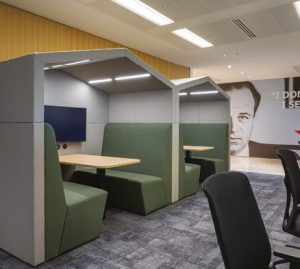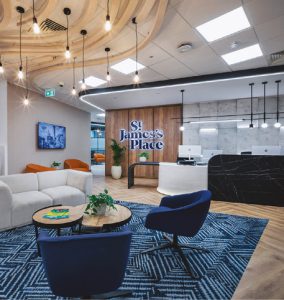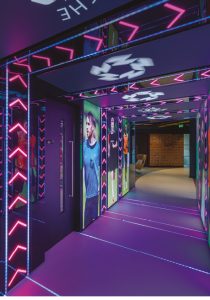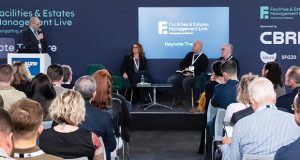CLIENT PROFILES
Workplace demands may have evolved but clients’ needs may vary according to their individual circumstances and their sector. Claremont has always been conscious of not being reliant on one specific sector because while one might be very buoyant, another might be experiencing a downturn.
The legal and professional services sector has always been a consistent one for the company, and while even the more traditional legal sector may be reconsidering the amount of space they require, they’re still very focused on making their workplaces somewhere which draw people into the office. Claremont also has a strong presence in the housing association market, gaming and technology and food and beverage.
Adds Flannery: “We also like to look at some test areas to check if there is a potential market there or not. For instance, we’re testing doing some work for new markets. But I think the most important thing is having an eclectic mix and not a focus on one specific sector.”
CLIENT NEEDS
The main concerns for clients whatever their sector, are in achieving sustainability goals, reducing costs and flexing for the future needs of the workplace. While Claremont’s own sustainability policies are to cut carbon emissions and support social value, they also take a practical approach to meeting environmental goals with clients.
“It’s about understanding where sustainability features in the client’s list of criteria, as for some it’s imperative to them, while with others, whereas they are concerned about it, there are perhaps other factors that drive this.”
“However, many clients are increasingly aware that their employees and talent pool want to see sustainability in play, and when they are recruiting people their sustainability statement maybe important to the future employee. This is why sustainability is much more prevalent and much more important now than it ever used to be.”
Project teams will take a pragmatic approach by using practical solutions that don’t necessarily have cost implications; for instance, reusing products, such as carpets, furniture or lighting. Alongside this, manufacturers and their partners are increasingly developing products that don’t have necessarily a huge cost implication by being more sustainable. Allied to sustainability, flexible design solutions which can be reworked without incurring costly and environmentally unfriendly refits are gaining traction.
 “Gone are the days where you would build structures that couldn’t be changed, moved or adapted,” says Flannery, “because clients generally don’t know what their business will look like in two, three- or four-years’ time, when we’re talking about their projects, we will always look at future proofing. We’ll ask, ‘where are we on day one? What could that look like in year two, year three?, We’ll put in the infrastructure to support that and make sure that everything that’s in that space is flexible or could be repurposed or moved.”
“Gone are the days where you would build structures that couldn’t be changed, moved or adapted,” says Flannery, “because clients generally don’t know what their business will look like in two, three- or four-years’ time, when we’re talking about their projects, we will always look at future proofing. We’ll ask, ‘where are we on day one? What could that look like in year two, year three?, We’ll put in the infrastructure to support that and make sure that everything that’s in that space is flexible or could be repurposed or moved.”
Furniture pods she says are here to stay and designers are supporting flexible workspaces by finding ways of dividing up space with movable structures, whether that be acoustic panels or curtaining rather than fixed partitions.






